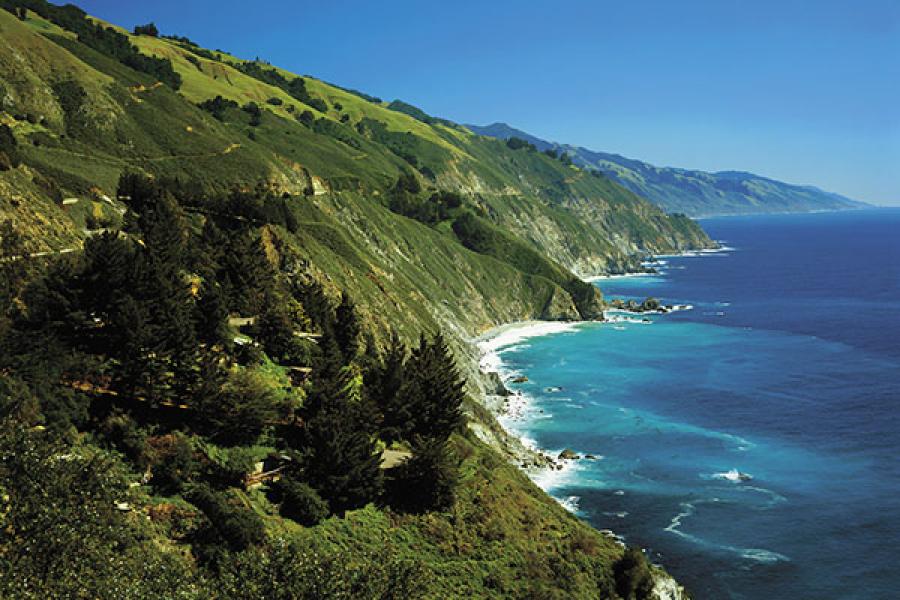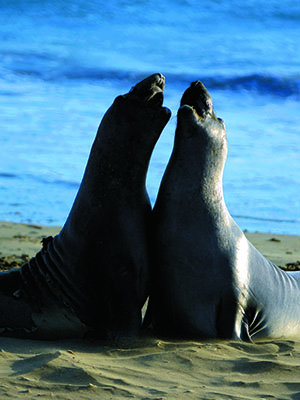
Big Sur: When land and sea collide
A road trip through California's Big Sur is a visual feast as the Pacific Ocean crashes into the coastline's cliffs. Watch out for the zebras, though
A hundred-and-thirty-six kilometres isn’t too daunting. It’s just a little less than the distance between Mumbai and Pune and, on most days, driving 136 km would not take more than a couple of hours, especially on a highway. On the Autobahn in Germany, you could do that distance many times over in a single day. But the 136 km between the Californian towns of Carmel and San Simeon, via State Highway 1 could (and should) take more than that—at minimum, a couple of days. The region, called Big Sur, is famous for its rugged coastlines, scenic drives and incredible wildlife and ecology. You wouldn’t want to rush this.
Despite the multitude of tourists I saw on my way through Big Sur (I drove the length of it last December), its popularity is fairly recent, relative to similar stretches like, say, the Amalfi Coast in Italy. That’s because until the 1930s, the area was inaccessible, its sights and sounds locked away from the world. A need for coastal safety was to change that.
The Californian coast, with its rocky shores and strong currents, has always been prone to shipwrecks. The toll was particularly high during the California Gold Rush (from 1848), when the volume of sea traffic increased as San Francisco became the gateway to the gold towns where miners lived and worked. After a ship called the Ventura ran aground in 1874, a lighthouse at a promontory called Point Sur was built in 1889. It was the start of human development of the area that would come to be known as Big Sur, culminating in the current route of California State Highway 1, which was completed in 1937.
Until then, very few settlers lived in the area; those who did were all hardy families who would battle the elements and the remoteness to raise livestock, grow food and marvel at the glorious surroundings, but always with respect for the raw force of nature that could easily turn their fortunes. Most of the landmarks in and around Big Sur such as Mount Manuel, Pfeiffer Ridge, Post Summit, Cooper Point, Dani Ridge, Partington Cove and others bear the names of these early settlers. Some of their descendants still live in the region.
The easiest way to reach Big Sur is to plan a road trip from San Francisco, where car rentals are cheap and plentiful. The road doesn’t have any gradients or switchbacks worth speaking of, so even a hatchback will do. The drive down from San Francisco to the town of Monterey is scenic, but it’s after you complete the 17-Mile Drive, a stretch of road between Monterey and Carmel, that you actually enter Big Sur. In one direction, stretching as far as the eye can see, you have the deep blue of the Pacific, flecked with foam and green where rocks and seaweed interrupt the waves. In stark contrast to this is a dun-coloured bluff—the cliff face, scraped bare by the wind. A ribbon of tarmac runs along the cliff and below it till the water’s edge is the green of vegetation and shrubbery, populated by birds and flowers and bees. It is almost a Biblical revelation, a glimpse into the Garden of Eden. Don’t take my word for it: Playwright and author Henry Miller, who lived here periodically from 1944 until 1963, called it “the face of the earth as the Creator intended it to look”.
Miller wasn’t the only famous author to call Big Sur home, at least for a bit. Hunter S Thompson and Jack Kerouac both lived there for a while, as did the poet, Robinson Jeffers, and photographer Edward Weston. As you drive through the region, you can see many relics of their time here—the Henry Miller Memorial Library is the largest of these, but you can visit significant places from the lives of all of the region’s celebrities.
That said, the main reason to go to Big Sur isn’t cultural or literary. It is to witness the greatest meeting of land and sea, where the Pacific Ocean crashes into the cliffs that lead into the Santa Lucia Mountains. For kilometre after kilometre along the winding highway, each turn brings a new view that demands a halt and a deep intake of breath. Only after that does presence of mind kick in and one reaches for a camera.
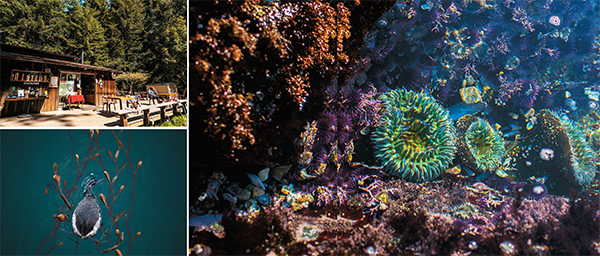
Many hues of the sea: (Clockwise from right) A duck roots for prey among the piers at Fisherman’s Wharf at Monterey; the Henry Miller Memorial Library; a multitude of colourful creatures in small pools near the ocean on the Big Sur stretch
At one point, I remember stopping my little Toyota car and sitting still, feeling the vehicle buffeted by the wind, rocking gently on its suspension as I surveyed the scene before me. This was the first day of the drive, and it was close to dusk. I was still raw from the city and all this big, bold, in-your-face landscape was getting a bit too much for me to handle. I noticed a pair of women with buckets, clambering about on the rocks below to get to tidal pools, little areas of seawater that remain trapped by rocks near the ocean. During high tide, the rocks are submerged and when the tide turns, the water that is trapped in a hollow between the rocks forms a pool.
I ventured forward to see what they were up to.
It soon became apparent that they were harvesting some kind of shellfish from the rocks lining the pools. In one of the shallow, foot-deep pools, which I had finally been able to look down into, were a multitude of colourful creatures. It had all the shock and pleasure of diving into the deep and seeing a vibrant coral reef with kelp forests and millions of fish.
There were anemones, sea urchins and organisms that I knew nothing about; many had tentacles and in the most brilliant of hues. They crowded each other, spilling over at times when the waves lapped against the sides of the pool.
The waves themselves are critical to the existence of the micro-Eden I was looking at. They slosh in nutrients and provide the life-force for the tiny ecology. Vivid pinks, purples and reds contrasted the carpet of blue water and the grey of the rock the little creatures were anchored in. It took me a good hour to wrench myself away from this hidden world.
As it grew darker, I knew I’d be missing out on similar sights if I drove at night and, so, I tried to find a place to camp. Inns and B&Bs are available in Big Sur, but at outrageous prices. But the Bureau of Land Management, a US federal government agency tasked with preserving and sustaining America’s public lands, had designated a few sites for camping in the scrub forest bordering the road. There are quite a few restrictions, though: No open fires, no cooking, no using ground water, and so on. The last two were no problem; there was no ground water around for me to tap into and I had plenty of sandwiches filled with half a roast duck purchased the day before in San Francisco’s colourful Chinatown. The first rule, though, would be a problem. I could have used a fire to fight the cold of the night.
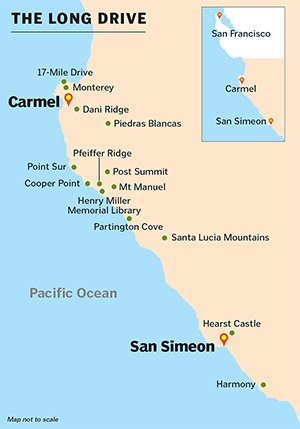
Big Sur boasts of many such locations, where, for anything between $8 and $25 a night, you can pitch a tent and sleep among redwood groves, or on a cliff, or even by a stream. However, on that first night, I had to make do with dreaming of these luxuries. After a night of tossing and turning and trying to stay warm, I was on the road again the next morning.
A few kilometres down the road, I looked far out into the sea and noticed a little puff of spray. I soon saw one more, and then yet another. There was a whole pod of orcas, the white spray from their blowholes evident against the calm blue of the ocean. Although I wasn’t close enough to discern the details, the sense of standing at the edge of a cliff and watching these majestic creatures cavort in the ocean was one of extreme peace and satisfaction.
The rest of the day followed a similar pattern. I paused with the other tourists to take pictures at Limekiln State Park where limestone was quarried and put into kilns to create quicklime, a vital ingredient of concrete. I also saw the last of the Santa Lucia Mountains behind me as the landscape turned from cliff-side driving to a more sedate coastal road. But the ruggedness of the terrain was still apparent at every metre of the highway.
Also more perceptible was the local wildlife. A little further on from the whales, I came to Piedras Blancas, an area of Big Sur where elephant seals have formed a rookery. These giant creatures are protected by the law now, but until 1972, which is when the Marine Mammal Protection Act (MMPA) came into effect, they were hunted almost into extinction for their blubber (fat), which is second only to sperm whale blubber. In fact, the elephant seal was long believed to be extinct even before the MMPA, until a small colony of seals was found on an island off Baja California in Mexico. From this colony, the seals have managed to repopulate and are now back in growing numbers each year.
The giant creatures, some of them over 2,000 kg, were sunning themselves. They could well be building up the motivation to head out to sea. Most of them were noisy, especially the pups, who were born a few months ago and were not weaned from their mothers.
Further on, I encountered the strangest sight yet. I spotted an animal that had no natural reason to be found in California. As I rounded a curve, I had to brake and look back—zebras, four of them. What was an animal that ought to have been in Africa doing on the posh West Coast of the US? The answer was a few miles away, on the outskirts of San Simeon, where the Hearst Castle is located.
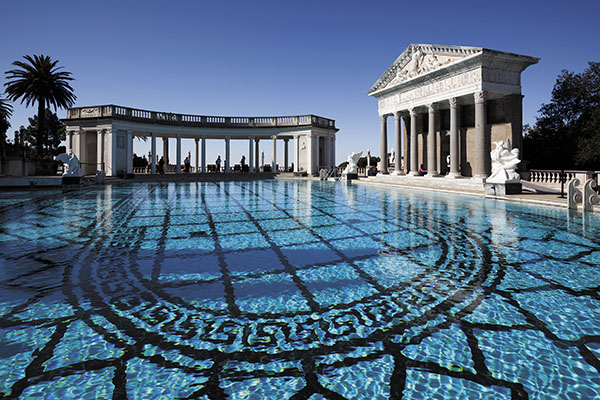
A sense of surreal: The Hearst Castle is spread over 90,000 sq ft. It has 56 bedrooms, 61 bathrooms, gardens, tennis courts and indoor swimming pools
William Randolph Hearst was a 19th century American newspaper publisher who helped shape what came to be known as yellow journalism through his paper, The New York Journal. He was the real life inspiration for Charles Foster Kane, the lead character of Orson Welles’s Citizen Kane. Hearst Castle, construction of which began in 1919, is surreal: Spread over 90,000 sq ft, it is part Playboy Mansion and part Fortress of Solitude (Superman’s occasional headquarters). It was one of the most exclusive places one could be invited to. Hearst had a private train that would ferry celebrities and politicians like Charlie Chaplin, the Marx Brothers, Greta Garbo, Joan Crawford, Franklin D Roosevelt, Winston Churchill and a galaxy of other stars from Los Angeles up to his castle.
Apart from the 56 bedrooms, 61 bathrooms, gardens, a theatre, library, airfield, tennis courts and indoor swimming pools, it had a zoo that housed African and Asian antelope, camels, sambar deer from India, red deer from Europe, axis deer from Asia, kangaroos, ostriches, emus, musk oxen and yaks. There were lions, tigers, leopards, jaguars, cougars, chimpanzees, orangutans, monkeys, a tapir and an elephant. And, of course, zebras.
In 1937, following the decline of the Hearst family fortunes, the zoo was shut down and by 1953 all the animals were relocated to other zoos except for a few species such as elk, sheep, goats and zebras, the descendants of which I saw in meadows surrounding the castle leading up to Highway 1. In 1958, the castle was donated to the state of California and the house continues to be a landmark that can be visited for a $25 ticket. Hearst Castle (or the Ranch as it is known locally) is one of the last landmarks of Big Sur. By the time you reach it, the mountains are long past and while the land is still rolling and pastoral, in the distance you can see civilisation’s encroaching footprint in the form of San Simeon, the town that marks the end of Big Sur.
Here, the land gives way slowly to cultivation, as horse ranches and vineyards spring up where earlier one would have seen lush forests or at least scrub bush. The absolute last holdout of the Big Sur lifestyle comes in the form of the little hamlet called Harmony (population 18), which is technically not even in Big Sur; it lies south of the town of San Simeon. This is then, the true final end of the road. After this point, you’re leaving Big Sur—and harmony—for the outside world.
(This story appears in the Sept-Oct 2015 issue of ForbesLife India. To visit our Archives, click here.)
-
 Coolsap
CoolsapVery aptly written. I live in San Jose and I completely agree with the author. You should also had been to Pismo beach which is further down CA 1 and Carmel town which is next to 17 mile drive.
on Oct 23, 2015
